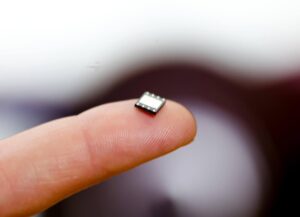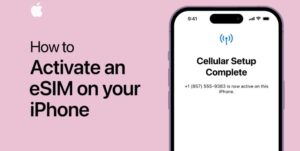Ok, so you’ve read our post that explains what eSIMs are and are intrigued by their many benefits – but you can’t quite wrap your head around how they work.
Or, have you recently discovered the idea of eSIMs and are after a little more info before potentially taking the plunge?
Well, in either case, we’ve got you covered – as this post explains how an eSIM works in clear and simple terms.
How traditional SIM cards work
To understand how eSIMs function, let’s first take a look at the purpose of traditional SIM cards and how they work.
A SIM, which stands for Subscriber Identity Module, contains all the software and data that enables a device to be authenticated, and then securely connect to a particular network. This includes data relating to the network provider, i.e., Vodafone, T-mobile, etc., and the end user’s subscriber data, i.e., their phone number, the type of mobile plan they signed up for, and so on.
Subsequently, when you want to purchase a plan from a network provider, the process presently goes something like this:
- You select and purchase a plan from a network provider
- If you bought the plan in a store, you’ll receive the SIM right there, but if you got it online, you’ll wait to receive it in the mail
- You install the SIM into your mobile device
- Your device uses the data stored on the SIM to connect to the network provider
If, later, you want to switch to another network, you’d need to remove the SIM from your device and repeat the above process with your new network.

Embedded SIMs and remote provisioning
eSIM stands for embedded SIM and differs from traditional SIM cards in three notable ways: they’re rewritable, they don’t come pre-loaded with data, and are soldered into a mobile device instead of being removable.
If a device has an eSIM installed, the network provider can upload their connectivity credentials and subscription data over the internet via a process called Remote SIM Provisioning (RSP). Once this process is complete (and it only takes a few seconds), your eSIM will be in the same state as if it were a physical SIM card and connect to the network in the same way.
An eSIM’s rewritable nature and the RSP software used by networks means that the process of purchasing a plan from a network provider now looks like this:
- You choose a plan from a network, from your mobile device and purchase it.
- The network provider sends you a QR code and activation instructions.
- You scan the code to download and activate your plan.
By removing the physical SIM from the equation, the process of joining a new network becomes 100% digital. Instead of having to acquire, and in some cases, wait for, a SIM card, you’re able to manage the activation process remotely and get connected instantly. Remote provisioning works out great for the network providers too, as they save on the cost of producing, storing, and distributing physical SIMs. Plus, in doing away with SIM cards, that’s tonnes of plastic no longer making its way into landfills – so the planet wins too!
However, while SIM cards only allow you to connect to one network, eSIMs can store data from multiple network providers. An eSIM allows you to store this network data in the form of a SIM Profile, with each acting like a separate SIM card. So, say you needed a separate number or data plan for work, you would choose a new plan from your mobile device, download and activate it – all with just a few taps and swipes of your finger.

Similarly, you can download a data plan from a network provider in a country you’re travelling to, so you’re able to get online as soon as you’ve touched down. This allows you to both save a fortune compared to international roaming fees and avoid the hassle of finding a local, prepaid SIM card when you arrive.
I Know How eSIMS Work Now, Nice! – How Do I Get My Hands on One?
Fabulous! Well, here at esimpop, we feel every day is an opportunity to learn, which is why we’ve spent the last few years building the ultimate eSIM guide featuring a comprehensive selection of the best eSIM plans from over 200 mobile operators across 180+ countries and territories.
Once you’ve looked at our list of eSIM-compatible devices and confirm your device contains an eSIM, simply select a network provider from our list of plans, pay them directly, receive your eSIM credentials instantly by email, and get set up immediately by following the instructions provided. Et Voila!






